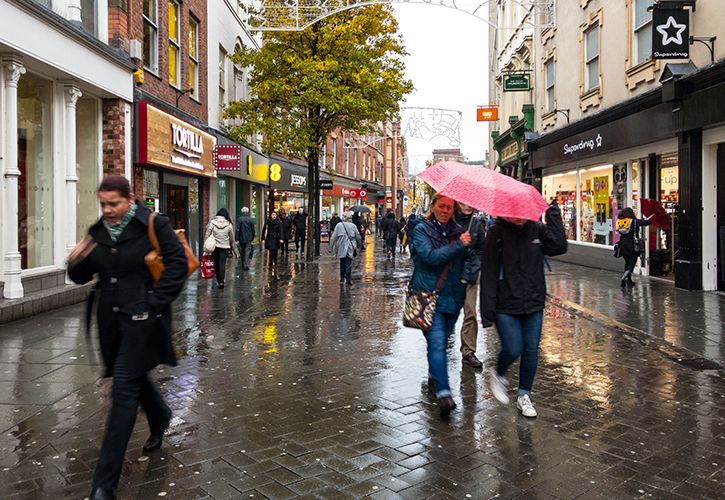UK DIY News
Retail Hit By Wettest February On Record

The BRC has published retail sales data covering the four weeks 28 January – 24 February 2024.
Sales figures are not adjusted for inflation, however, the February SPI (BRC) and January CPI (ONS) show inflation running at higher than normal levels these positive sales figures mask a likely drop in volumes. As inflation falls in the coming months, retail sales figures will also naturally fall at the same time.
Key points:
- UK Total retail sales increased by 1.1% year on year in February, against a growth of 5.2% in February 2023. This was below the 3-month average growth of 1.4% and below the 12-month average growth of 3.1%.
- Food sales increased 6.0% year on year over the three months to February, against a growth of 8.3% in February 2023. This is below the 12-month average growth of 7.9%. For the month of February, Food was in growth year-on-year.
- Non-Food sales decreased 2.5% year on year over the three-months to February, against a growth of 3.2% in February 2023. This is steeper than the 12-month average decline of 0.9%. For the month of February, Non-Food was in decline year-on-year.
- In-store Non-Food sales over the three months to February decreased 2.3% year on year, against a growth of 8.1% in February 2023. This is below the 12-month average growth of 0.3%.
- Online Non-Food sales decreased by 4.1% year on year in February, against a decline of 3.1% in February 2023. This was steeper than the 3-month and 12-month declines of 2.9%.
- The online penetration rate (the proportion of Non-Food items bought online) decreased to 35.7% in February from 36.1% in February 2023.
Helen Dickinson OBE, Chief Executive of the British Retail Consortium, said:
“Consumer demand was dampened by the wettest February on record, translating into a poor month of retail sales growth. Not even Valentine’s Day lifted customers out of the gloom, and gifting products that typically sell well, like jewellery and watches, failed to deliver. On the sunnier side, rainy weather did brighten sales of toys, as parents looked for ways to occupy their children indoors.
“With consumer confidence and demand remaining weak, Government must find ways to stimulate the economy. Retailers have some Government induced cost hurdles to jump in the coming months including a £400m business rates rise based on last September’s 6.7% inflation rate. By using Wednesday’s Budget to reduce this, the Chancellor will lend a helping hand to much needed investment in businesses and local communities up and down the country.”
Linda Ellett, UK Head of Consumer Markets, Leisure & Retail, KPMG, said:
“Cuts in national insurance rates designed to put more money in people’s pockets have so far failed to translate to a boost to consumer spend on the high street, with retail sales growth in February recording a limp 1.1%.
“Health and beauty categories continued to drive sales both on the high street and online, whilst sales of home and dining accessories received an unexpected boost last month, as consumers moved from buying clothes to buying cushions and cooking items. With food inflation slowing, sales of food and drink remained strong at 5%, but this was slightly down on January’s figures.
“As many households continue to adapt budgets to meet higher essential costs, including higher mortgage rates, consumer reluctance to get out there and start spending is likely to remain in the short term. With big increases in labour costs and business rates just weeks away, adding to an already stressed cost agenda for retailers, many will be pinning their hopes on some good news in the Chancellors’ Spring Budget this week to help kick start a spending revival on the high street. As inflation continues to slow over the coming months and household finances are expected to improve, there is some light at the end of the tunnel for weary households. However, the assumption that having more spending power will lead to more spending isn’t cutting through at the moment, and retailers will continue to face significant downward pressures on demand in the months to come.“
Food & Drink sector performance | Sarah Bradbury, CEO, IGD, said:
“The UK grocery market saw sales and volumes both increasing from last year, with February the third month in a row where volumes were in year-on-year growth. However, although sales were also up on last year, they were down compared to the previous month. This is the fifth month in a row this has occurred, and the trend is likely to continue as inflation leaves the market.
“Following news that the UK entered a technical recession over the festive period, shoppers were feeling slightly less positive in February than they were in January. However, confidence levels didn’t slip as far as they could have, with the promise of lower energy bills on the horizon and indications that the recession could in fact already be over playing a role here.”
Source : BRC
Image : Jason Batterham / Shutterstock.com / 671551474
I find the news and articles they publish really useful and enjoy reading their views and commentary on the industry. It's the only source of quality, reliable information on our major customers and it's used regularly by myself and my team.











































